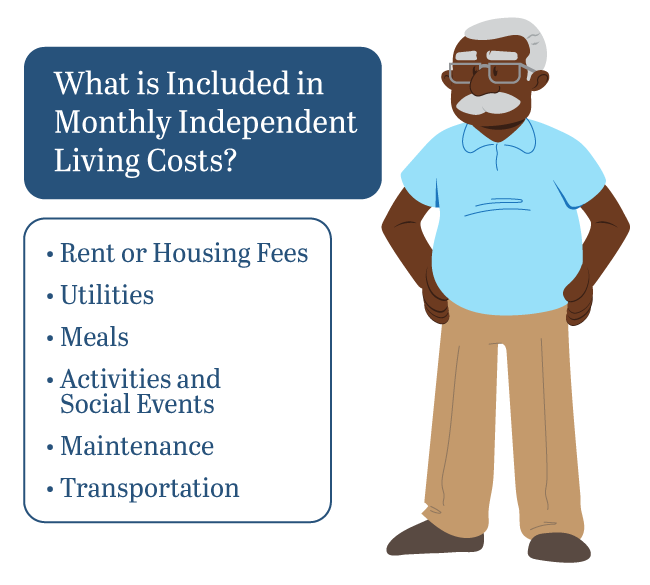Thinking about a move to an independent living community? Many older adults find the idea appealing—and for good reason.
These communities offer a lifestyle free from home maintenance and chores. Plus, they provide social activities and opportunities for social connections that can make retirement more enjoyable. But one big question always comes up: What’s the cost of independent living? And can I even afford it?
What is Independent Living?
Independent living is designed for older adults who are generally healthy and self-sufficient. It’s all about enjoying life without the responsibilities of homeownership. That means no more yard work, cooking, or cleaning—unless you want to.
Independent living communities usually offer different housing options, from apartments to cottages, to suit various needs and preferences. They also often feature a variety of amenities included, such as fitness centers, swimming pools, and game rooms. Some independent living communities also provide transportation services for their residents.
How Much Does Independent Living Cost?

Let’s face it, costs are a major factor in making your decision. The truth is, the price varies greatly.
However, this type of community can sometimes be less expensive than assisted living or memory care. This is because you’re primarily paying for housing, amenities, and some services, not personal care. The average cost of independent living nationwide was $3,065 in 2024, but this is just a general idea.
4 Key Factors That Affect Independent Living Costs
Many things can influence what you’ll actually pay for independent living:
- Location: Just like with any housing, where you live plays a huge role. A community in a bustling city will likely cost more than one in a more rural area. The rising cost of living can really impact independent living costs.
- Amenities: Resort-style amenities are fantastic but come with a price tag. Communities with pools, fitness centers, salons, and organized activities often charge higher monthly fees.
- Apartment Size and Type: You guessed it. A spacious two-bedroom apartment will generally be pricier than a cozy studio. Some communities may offer cottages or townhouses, too, which might affect your cost.
- Services Included: Think about the services that are important to you. A meal plan, weekly housekeeping, or transportation options will often factor into the overall price.
What is Included in Monthly Independent Living Costs?

-
Rent or Housing Fees
This is your primary cost, covering your living space. This cost can vary based on the size and type of your unit, such as a studio apartment or a two-bedroom.
-
Utilities
Many communities include heat, water, electricity, and basic cable in the monthly rent. However, this varies, so make sure to ask.
-
Meals
Most communities include at least one meal per day in their monthly independent living costs, while some offer full dining plans. Meals are usually served in a communal dining area, providing opportunities for residents to socialize.
-
Activities and Social Events
Get ready to fill up your social calendar. Many communities offer various events and activities as part of your fee, making it easier to connect with others. These events could include anything from fitness classes and game nights to outings to local attractions.
-
Maintenance
One of the best perks is saying goodbye to home repairs and upkeep, which is typically handled by the community staff.
-
Transportation
Some communities provide shuttle services to appointments, shopping centers, or local events. This service can be a lifesaver for seniors who are no longer able to drive themselves.
Beyond the Basics
On top of the basics, communities often have extra services you can choose for an additional cost:
- Additional Meals or Special Dietary Options: If you have specific dietary needs or want more flexibility, you may be able to purchase additional meals or request special options.
- Housekeeping and Laundry Services: While basic maintenance is generally included, you can often pay extra for more frequent housekeeping or help with laundry.
- Personal Care Services: If you find you need a little help with personal care tasks, like bathing or dressing, some communities offer these services for an extra fee.
Be sure to ask each community about the fees for any services not included in the base price. With more and more baby boomers retiring, the demand for senior living is only growing. The average retirement age in 1991 was only 57. Fast forward to today, it’s climbed to 61, meaning those communities need to be prepared for an influx of new residents as we age.
And that’s not all. By 2030, baby boomers are all going to be 65 or older, which experts believe is why the National Investment Center for Seniors Housing & Care’s 2024 analytics predict a big improvement in senior housing occupancy. All this means as more people need these services, understanding independent living cost will become crucial for families.
FAQs about Independent Living Cost
Spend Your Golden Years Stress-Free
Making a decision about independent living costs is about more than crunching numbers. It’s about envisioning a fulfilling lifestyle. Comparing costs and figuring out your budget will ultimately give you the confidence to choose the right community.
Independent living cost is a big factor, but don’t forget to consider those priceless aspects: freedom, friendships, and an enjoyable retirement.
Finding a home is one of the most important experiences in life. Choosing the right place for you whether a permanent residence, a hotel, or a senior home can become very challenging when you don’t have the right guide.
At Senior Home Transitions, we are committed to helping families make the home search experience as pleasant as possible. Whether you need memory care, independent living, or skilled nursing facilities, we are here to take the challenge off you and match you or your loved one with the perfect home for your special needs.
Call us today for FREE placement services.



